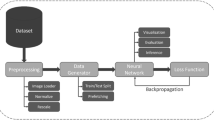Abstract
Volume representations of blood vessels acquired by 3D rotational angiography are very suitable for diagnosing an aneurysm. We presented a fully-automatic aneurysm labelling method in a previous paper. In some cases, a portion of a “normal” vessel part connected to the aneurysm is incorrectly labelled as aneurysm. We developed a method to detect and correct these erroneous border areas. Application of this method gives better estimates for the aneurysm volumes.
Access this chapter
Tax calculation will be finalised at checkout
Purchases are for personal use only
Preview
Unable to display preview. Download preview PDF.
Similar content being viewed by others
References
Kemkers R, de Beek JOp, Aerts H, et al. 3D-rotational angiography: First clinical application with use of a standard Philips C-arm system. In: Proc. CAR 98. Tokyo, Japan; 1998. 182–187.
Bruijns J. Local distance thresholds for enhanced aneurysm labelling. Procs BVM 2005; 148–152.
Bruijns J, Peters FJ, Berretty RPM, et al. Computer-aided treatment planning of an aneurysm: The connection tube and the neck outline. In: Proc. VMV. Erlangen, Germany; 2005. 265–272.
de Bruijne M, van Ginneken B, Viergever MA, et al. Interactive segmentation of abdominal aortic aneurysms in CTA images. Med Image Anal 2004;8(2):127–138.
Bescos JO, Slob MJ, Slump CH, et al. Volume measurement of intracranial aneurysms from 3D rotational angiography: Improvement of accuracy by gradient edge detection. AJNR Am J Neuroradiol 2005;26(10):2569–2572.
Wong WCK, Chung ACS. Augmented vessels for quantitative analysis of vascular abnormalities and endovascular treatment planning. IEEE Trans Med Imaging 2006;25(6):655–684.
Bruijns J. Semi-automatic shape extraction from tube-like geometry. In: Proc. VMV. Saarbruecken, Germany; 2000. 347–355.
Bruijns J. Fully-automatic branch labelling of voxel vessel structures. In: Proc. VMV. Stuttgart, Germany; 2001. 341–350.
Bruijns J, Peters FJ, Berretty RPM, et al. Shifting of the aneurysm necks for enhanced aneurysm labelling. Procs BVM 2006; 141–145.
Philips-Medical-Systems-Nederland. INTEGRIS 3D-RA. Instructions for use. Release 2.2. Philips Medical Systems Nederland. Best, The Netherlands; 2001.
Author information
Authors and Affiliations
Editor information
Editors and Affiliations
Rights and permissions
Copyright information
© 2007 Springer-Verlag Berlin Heidelberg
About this paper
Cite this paper
Bruijns, J., Peters, F.J., Berretty, R.P.M., Barenbrug, B. (2007). Fully-Automatic Correction of the Erroneous Border Areas of an Aneurysm. In: Horsch, A., Deserno, T.M., Handels, H., Meinzer, HP., Tolxdorff, T. (eds) Bildverarbeitung für die Medizin 2007. Informatik aktuell. Springer, Berlin, Heidelberg. https://doi.org/10.1007/978-3-540-71091-2_59
Download citation
DOI: https://doi.org/10.1007/978-3-540-71091-2_59
Publisher Name: Springer, Berlin, Heidelberg
Print ISBN: 978-3-540-71090-5
Online ISBN: 978-3-540-71091-2
eBook Packages: Computer Science and Engineering (German Language)




